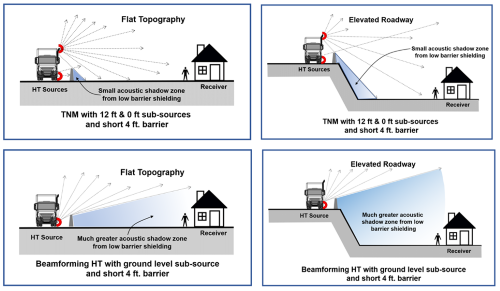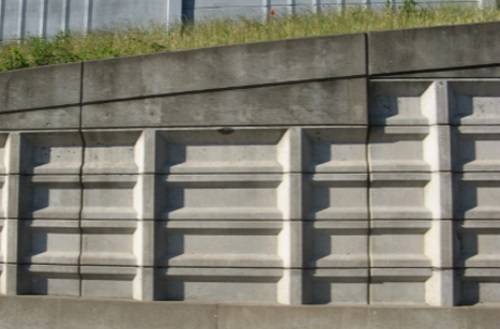State departments of transportation across of the country are looking at new and better ways to predict traffic noise levels, as well new materials for highway sound barriers, in order to reduce the overall cost of noise abatement efforts.
[Photo courtesy of the Missouri Department of Transportation.
This second of a two-part series on state DOT noise abatement strategies examines some of the research state DOTs are conducting to find more cost-effective and innovative designs and materials to mitigate the high levels of roadway noise: everything from using less expensive materials or smaller barriers to designing duel use barriers such as vegetation walls and solar panels.
Traditionally, sound wall barriers are pre-cast or cast-in-place concrete sections. However, several different types of materials have been in use since the beginning of sound barrier construction in the 1960s. The latest noise barrier inventory – maintained by the Federal Highway Administration –indicates barriers constructed with a single material make up 84% percent of all noise barriers. Furthermore:
- Concrete comprises 55 percent of those barriers.
- Block represents 18 percent of those barriers.
- Wood comprises 5 percent of those barriers.
- Metal, berm, and brick together account for another 5 percent of single material barriers.
- “Other” materials comprise the final 1 percent of those barriers, including acrylic, composite, fiberglass, glass, opaque plastic, and transparent plastic.
There are noise walls designed with absorptive material to absorb sound, but the majority are built to deflect sound. Barrier analysis and design must meet the requirements of federal regulation 23 CFR 772 for all federally funded projects.
The Ohio Department of Transportation is in the start-up phase of a research project expected to begin January 2021 to look at the effectiveness of vinyl fence as a noise barrier as opposed to the now-standard concrete barriers. The project involves constructing two 8-foot tall vinyl fences at two different locations, testing them for noise reductions, and comparing the reductions to nearby concrete noise walls.

The Ohio DOT plans to use readily available vinyl fence materials that already have specifications available – indeed, one type of fence earmarked for testing is available at the local Home Depot.
Noel Alcala, the noise and air quality coordinator at the Ohio Department of Transportation and noise workgroup coordinator on behalf of the American Association of State Highway and Transportation Officials, explained in an interview that while vinyl is a lot less durable overall than concrete, it is “a lot less expensive and we have an indication that the noise reduction will be very noticeable.”
The Ohio DOT is also studying the feasibility of using vegetation growing on noise walls as both a sound absorber and an air quality improvement and plans to complete a report on that effort by the end of 2020. That effort – based on research conducted in 2010 – looked at a 400-foot long section of “green noise wall.” That wall consisted of a 12-foot-high section of stacked, 70-pound bags sprouting plants and grass as a way to muffle highway sound.
Trees and shrubs can decrease highway-traffic noise levels if high enough, wide enough, and dense enough, but it would take at least 100 feet of dense vegetation to provide the same benefit as the smallest feasible noise wall. Because of this, the FHWA has not approved using vegetation for noise abatement.
However, future studies could show more innovative choices will result in higher levels of noise absorption. For instance, environmentally friendly and sustainable bamboo growth may provide the needed noise level abatement to meet FHWA requirements. One feasibility study presented at the 2016 International Congress and Exposition on Noise Control Engineering indicated that the noise-reducing effect of a bamboo barrier with a height of 5 meters (roughly 16 feet) and a thickness of 6 meters (nearly 20-feet) is roughly comparable to a 3-meter (nearly 10-foot) high solid noise wall.
Some states are looking to try new noise barriers with a dual purpose. In 2018, for example, the Minnesota Department of Transportation completed a literature review, Harnessing Solar Energy through Noise Barriers and Structural Snow Fencing, on the topic.
That study found that sound barriers equipped with solar panels are used successfully in Europe, though there are no current in-place solar panel noise barriers in the United States. However, two states, Massachusetts and Georgia, are currently working with partners to pursue pilot studies using solar panels built into sound walls so they can produce renewable energy without compromising their abilities to reduce noise – and do so safely. Given the number of miles of sound barrier currently constructed in the United States – over 3,000 miles total – the study found the potential for energy production could be at least 400 Gigawatt hours annually, roughly equivalent to the annual electricity use of 37,000 homes.
The California Department of Transportation is also looking at innovative designs to save money on noise abatement construction.
Currently, Caltrans is exploring the feasibility and effectiveness of lower height barriers and berms. Its latest research suggests that at freeway speed, most all light-vehicle noise is at the tire/pavement interface — literally at the zero-foot level. Meanwhile, on most heavy trucks — even with tall exhaust stacks – most noise is below 3.3-foot level.
That means shorter less-expensive noise barriers would help attenuate noise. A low vehicle noise source also means a short (4-foot) solid-concrete safety-barrier could provide noticeable noise mitigation if positioned correctly in the road cross-section. Shorter barriers mean lower overall costs. State transportation agencies across the United States are making strides to protect the public from high levels of traffic noise. Click here for a list of current state DOT noise reduction projects.

